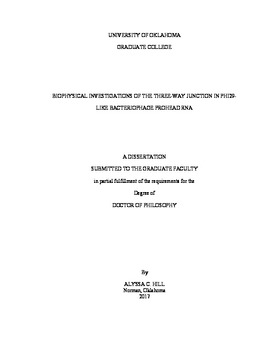| dc.contributor.advisor | Schroeder, Susan | |
| dc.contributor.author | Hill, Alyssa | |
| dc.date.accessioned | 2017-09-19T14:47:11Z | |
| dc.date.available | 2017-09-19T14:47:11Z | |
| dc.date.issued | 2017-08-18 | |
| dc.identifier.uri | https://hdl.handle.net/11244/52247 | |
| dc.description.abstract | The knowledge gained from biophysical studies of RNA can contribute to basic research and inform new directions for translational research. In particular, information that develops the relationships among RNA energetics, physiologic stability, and structure can contribute to better predictions of RNA structure from sequence and guide the rational design of functional supramolecular structures such as targeted therapeutics. A conserved three-way junction (3WJ) in noncoding viral prohead or packaging RNA (pRNA) uniquely captures many aspects of RNA structure and function and represents a model system for studying these relationships. This dissertation presents thermodynamics for pRNA 3WJs. Phylogenetically related 3WJs have a wide range of thermodynamic stabilities, and some sequences are more stable than a phi29 3WJ sequence that is used commonly in RNA nanotechnology. The range of thermodynamic stabilities observed is not explained fully by differences in sequence at the 3WJ core.
The prototype phi29 pRNA sequence is used commonly in nanotechnology, for example as a nanoparticle delivery vector for therapeutic drugs. Related sequences are underexplored. The successful translation of phi29-alternative 3WJs into clinical practice will depend on energetic stability and the ability to overcome several key physiological barriers. This dissertation also presents 3WJ stabilities in human blood serum and in cells. Energetic and physiologic stabilities are not always correlated, but some 3WJs are both more thermodynamically stable and more stable in serum than the phi29 3WJ. The results of cell uptake studies support the idea that phi29-alternative 3WJs may be useful in nanotechnology, for example, in stabilizing RNAs for drug delivery.
The coaxial stacking of helices across RNA 3WJs can be thermodynamically favorable and may account for some of the observed differences in 3WJ stabilities. Transmission electron microscopy (TEM) data for a helix-extended construct indicate that helices are distributed equally around the phi29 3WJ. The determination of the relative orientation of helices around the pRNA 3WJ can help shed light on how sequence and secondary structure at the 3WJ core influence global structure and may provide insight into why some 3WJs are more energetically and physiologically stable than others.
The work presented here contributes to parameters for better RNA structure prediction from sequence, expands the number of useful building blocks for RNA nanotechnology, and provides a method for further investigating structural mechanisms underlying pRNA stability and self-assembly. | en_US |
| dc.language | en_US | en_US |
| dc.subject | Biophysics, General. | en_US |
| dc.subject | Biology, Microbiology. | en_US |
| dc.subject | Biology, Molecular. | en_US |
| dc.title | BIOPHYSICAL INVESTIGATIONS OF THE THREE-WAY JUNCTION IN PHI29-LIKE BACTERIOPHAGE PROHEAD RNA | en_US |
| dc.contributor.committeeMember | Bartley, Laura | |
| dc.contributor.committeeMember | Dunn, Anne | |
| dc.contributor.committeeMember | Gaffin, Douglas | |
| dc.contributor.committeeMember | Russell, Scott | |
| dc.date.manuscript | 2017 | |
| dc.thesis.degree | Ph.D. | en_US |
| ou.group | College of Arts and Sciences::Department of Microbiology and Plant Biology | en_US |
| shareok.nativefileaccess | restricted | en_US |
